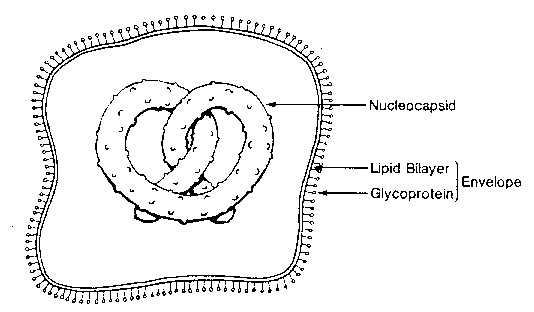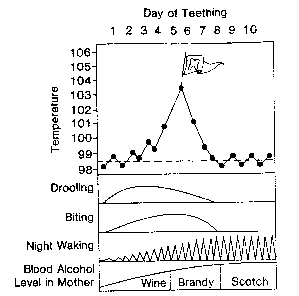The Teething Virus
The Teething Virus
By Howard J. Bennett, MD (Department of Health Care Sciences, George Washington University Medical Center) and D. Spencer Brudno, MD (Department of Pediatrics, Medical College of Georgia).
From Pediatr Infect Dis. 5:399-401, 1986.
Abstract
A prospective study was carried out on 500 teething infants which demonstrated that a new infectious agent, the human teething virus, is responsible for the febrile response that accompanies the eruption of deciduous teeth. Speculations are made concerning whether or not primary care physicians will began prescribing amoxicillin instead of Jack Daniel’s to treat teething infants and their parents.
Introduction
Teething has been the subject of intense interest in the medical and nonmedical community for centuries. [1] Controversy has resulted not only over the signs and svmptoms associated with teething but also over the tooth fairy’s impact on the family. [2,3] But perhaps the greatest controversy of all is whether or not teething causes fever. Unfortunately all of the research in this area suffers from serious methodologic flaws. McCartney et al [4] reported that teething was responsible for fever in 20% of infants with temperatures of at least 40 degrees C. That study was carried out in an emergency room setting, however, and therefore is not applicable to all infants. In addition the authors failed to quantitate the amount of drooling that residents had to contend with and whether or not this interfered with optimal observation of the patient. More recently Shorts [5] examined 240 teething patients in a suburban practice and concluded that teething does not cause fever. His population included school-aged children as well as infants, however, and it is well known that older children will feign illness in order to get stickers and other rewards from the doctor’s office. [6]
Early in 1982 one of us was doing histopathology research on the brain cells of hairless mice that had been subjected to 36 hours “on-call.” Inadvertently a sample of saliva from a teething infant (via a soggy bagel) was put under the electron microscope. To our amazement this accident uncovered a new viral particle (HJ Bennett, unpublished revelation). This discovery led to the diversion of all previously acquired grant funds into the search for the mythical teething virus. In this report we present the results of a prospective study of teething infants and young children undertaken during the Washington, DC teething outbreak of 1983 and 1984. We report our findings, which prove conclusively that the human teething virus (HT virus) is the hitherto elusive agent responsible for the fevers associated with teething.
Patients and Methods
The study included 500 infants who were followed prospectively from birth through 2 1/2 years of age. The patients were selected from consecutive term births at our medical center. Primiparous women were interviewed by one of the authors sometime during the third trimester, usually on the way to the delivery room. The mothers-to-be were asked two questions regarding possible entry into the study: (1) If you have a baby, would you like to participate in a study of teething in infants? (2) Do you believe in Santa Claus? A positive response to either question made the infant eligible for the study.
A total of 506 mother/infant pairs were initially included in the study. The patients were matched for socioeconomic status, educational background and whether or not both parents watched “Dallas” on Friday nights. Two infants with natal teeth were subsequently excluded, though it is worth noting that in both cases the mother experienced a “warm uterine feeling” 2 weeks prior to delivery. An additional four babies dropped out of the study for unknown reasons. Their mothers reluctantly withdrew from the project as well.
Mothers were instructed to bring their baby to the clinic at the first sign of teething. During this visit vital signs were taken and the infant was examined for physical evidence of teething using the method described by Leech. [7] Briefly this technique involves having the infant breastfeed for 5 minutes in the office. If the mother’s cry exceeds 90 dB, the baby is teething. The threshold is adjusted to 120 dB in nonnursing mothers. Infants were seen regularly during the teething period, and parents kept a diary of relevant symptoms.
Saliva was obtained on the fourth and sixth teething days by adsorption onto teething rings impregnated with human embryonic lung and human embryonic kidney. The specimens were processed using a revolutionary technique that is currently under investigation by a rival laboratory and therefore is not available for publication. Additional saliva was obtained from the subjects’ mothers and in between episodes of teething such that each patient served as his or her own control. Serum specimens were not obtained due to parental squeamishness. All subjects and specimens were handled in a triple-blind fashion: patients did not know why they were in the study, technicians did not know what was being studied, and the authors didn’t care but hoped to get published anyway.
Results
Basic research. The HT virus is a uniquely shaped viral particle with a diameter of 140 nm. The envelope surrounds a helical nucleocapsid that is covered with spherical studs (Figure 1). Though superficially resembling a slice of white bread, the HT virus is actually the first recognized member of a new family of RNA viruses to be named the masticoviridae. Details of the virus’ life-style and reproductive habits will be the subject of another report. [8]
Clinical research. The 500 patients in our study experienced repeated bouts of teething during the first 2 1/2 years of life. Teeth erupted at a rate of approximately 10 per year, which provided us with 5000 tooth-years of data. Eighty-four percent of patients became febrile during the teething process. The clinical course of these patients is shown in Figure 2. All patients recovered uneventfully from this developmental nuisance. Unfortunately. however, at least 15 divorces could be directly attributed to “irreconcilable differences” on how to manage a teething baby at three o’clock in the morning.
The HT virus was isolated by electron microscopy from well over 99% of febrile teething patients (Table 1). In fact there was only one febrile infant in whom the HT virus was not isolated, and the technician who handled that specimen admitted to misplacing the patient’s teething ring and secretly testing his own saliva (J Cama, personal confession). The HT virus was not isolated from any of the nonfebrile teething patients, though it was seen in two samples taken from the mothers’ group. In both cases, however, the mothers admitted to kissing their febrile babies just prior to submitting their own specimens for study.
Discussion
Infants acquire their primary teeth by 30 months of age. Teething occurs off and on for 24 of these months — mostly on, according to parents. We have shown that 84% of infants develop fever when teething and that it is the HT virus which causes this fever. There appears to be little doubt, therefore, that parents have been right all along. Fortunately, however, teething phobia can now be approached intelligently instead of with the irrational treatments of the past (Figure 3).
A few questions still remain, however, concerning the pathogenesis of the HT virus. We believe that primary infections with the virus occur early in life in the majority of children. These infections are probably subclinical most of the time but undoubtedly are also responsible for many of the “idiopathic” conditions of infancy, colic and difficult temperament to name a few. Once the primary infection subsides, the virus becomes dormant within the alveolar ridge. Then, at future points in time, the aggressive movements of erupting teeth disturb the sleeping virus who retaliates by producing local and systemic effects. The pattern of transmission is not horizontal, as one might expect, but gravitational, this of course owing to the aerodynamics of drooling babies.
As a result of this study, we have revised the anticipatory guidance given at 6 months of age. Parents are encouraged to check for teething at the first sign of fever and to quickly begin their prophylactic Valium if the baby’s Leech test is positive. Finally we recommend that practitioners approach their 2 a.m. calls as a time to educate parents about the positive aspects of teething. [9] This advice will minimize the hoarding of left-over amoxicillin until such time as a vaccine is developed to rid mankind of this pesky little virus.

Figure 1. Schematic representation of the human teething virus.

Figure 2. Schematic diagram illustrating the clinical sequence of teething.

Figure 3. The modern treatment of teething: an ice and alcohol bath.
Table 1. Isolation of the human teething virus by electronic microscopy in control and teething patients.
| Group | No. of Samples Tested | No. Positive for HT Virus | % Positive for HT Virus |
| Mothers | 500 | 2 | <1 |
| Nonteething infants | 1000 | 0 | 0 |
| Nonfebrile teething infants | 800 | 0 | 0 |
| Febrile teething infants | 4200 | 4199 | >99 * |
Acknowledgments
This work was supported completely by a grant from the makers of Orajel and Goldstein’s Bagel Shop. Special thanks to Judy Ratner, M.D., who somehow found the time to review our manuscript in between pelvic examinations in her adolescent clinic.
References
References
- Radbill SX: Teething as a medical problem: Changing viewpoints through the centuries. Clin Pediatr 4:556-559,1965
- Skinner BF: The tooth ransom: Are today’s children holding out for too much money? J Pediatr Bribery 86:314-316, 1980
- Westheimer R: Is 50 cents per tooth enough to get children to sleep in their own beds at night? J Parental Celibacy 69:123-128, 1982
- McCartney PL, Flintstone F, Rubble B. et al: Do teething infants need a CBC and blood culture? J Dubious Invest 59:463-468, 1977
- Shorts RH: Teething and fever: Another myth debunked. PMD Bull 21:459-463, 1982
- Munchausen BV: Factitious teething as a means to visit the pediatrician. Acta Idiotica Scand 70:212-213, 1978
- Leech LA: The clinical application of breastfeeding reflexes: “Let-down” means the milk is in, “Let Go!” means the teeth are coming. The Breast 36:24-34, 1982
- Bennett HJ, Brudno DS: The masticoviruses: Have we bitten off more than we can chew? Popular Virol, in press, 1986
- Weissman MI: Tootharche, menarche, and anarchy: Three developmental milestones of childhood and adolescence. Curr Prob Nightcall 12:1-7, 1983
Created 11/29/94 / Last modified 11/30/95
Neonatology on the Web / webmaster@neonatology.org
Last Updated on 03/07/24